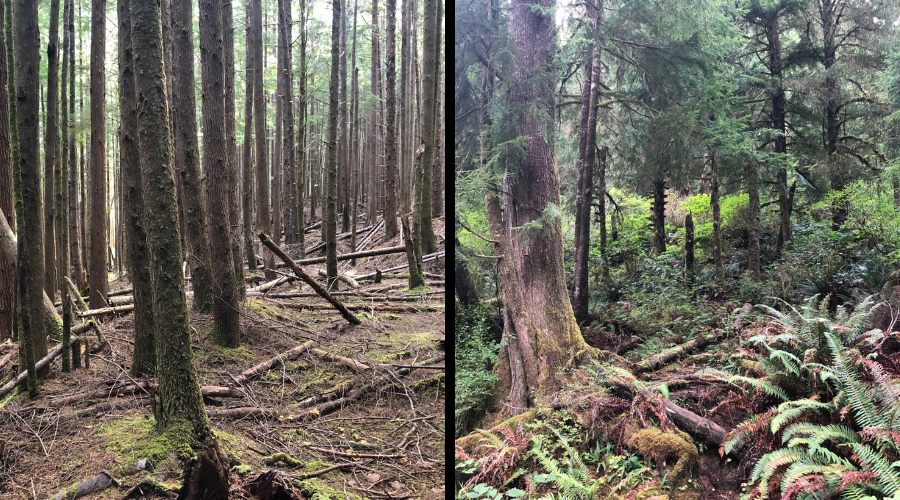
Dense stands of over-planted trees versus a healthy forest with a thriving understory.
North Coast Land Conservancy’s stewardship team is starting a restoration project at Boneyard Ridge Habitat Reserve to set the forest on an accelerated path toward becoming a healthy, functioning system.
All public access to that portion of Boneyard Ridge—which is adjacent to Circle Creek Conservation Center—is closed for the duration of the project this fall and winter. Visitors to Circle Creek should look for signage on the site. If conditions are safe, NCLC will reopen that part of Boneyard Ridge to public access in the spring.
The restoration will include selective thinning on about 40 acres of a 115-acre unit that was previously owned by an industrial timber company prior to NCLC’s acquisition. It was last harvested in 1960.
Although this unit includes some older trees, Stewardship Director Melissa Reich says, those will not be impacted by the thinning.
“We’re cutting the smaller, younger trees, or in areas where no trees were able to get large, because it was so densely planted,” she says.
Currently, these acres don’t contain a healthy forest. They primarily possess even-aged stands of trees that are predominately one species: western hemlock. There is not space or light for any one tree to grow in a healthy way. Meanwhile, the density of the trees is causing other negative impacts. There’s little to no light or vegetation on the ground and it’s not optimal habitat for wildlife.
If trees can’t grow larger, they don’t support epiphytic plants in the canopy or large nesting platforms for marbled murrelets, which then turn into big snags with nesting cavities for owls. Eventually, those large trees fall to the ground through natural disturbances to act as a big moss-covered sponge that will keep moisture even in the dry months.
“If you were to do an understory plant survey, it would be really quick,” Melissa says. “Maybe you could spot a sword fern in the distance where a speck of light hits the forest floor. Otherwise, there’s nothing on the forest floor except some wood and needles and dirt—maybe mushrooms this time of year.”
Providing Better Habitat
NCLC will be reducing the tree volume on these particular acres by about 30 to 40 percent. Doing so will set this portion of Boneyard Ridge on a trajectory to transforming from a tree farm to a healthy forest.
“Selective thinning can be used to accelerate the development of old-growth characteristics in a forest by increasing structural and species diversity within the stand,” explains Colin Meston, a forest ecologist who NCLC has contracted with to oversee the restoration project. “Structural diversity is increased by creating openings in the forest to allow for new trees to come in, as well as thinning out dense areas to promote growth in the larger trees, thus promoting a wide range of tree sizes and spacing.”
NCLC did a similar project on another unit of Boneyard Ridge in 2019. Each winter since then, the team has planted cedar and maple to increase species diversity. Additionally, selective thinning makes openings that encourage the growth of understory shrub and herbaceous plants.
“Thinning some of the trees is going to allow light to hit the forest floor,” Melissa adds. “And then not only will there be more diversity from some of the cedar that we’re adding, the sword ferns will start coming in, the salmonberry will pop in—all of the native shrubs that make up a healthy forest will return.”
Other benefits include an increase in logs and large pieces of wood, as all trees are staying on-site for large wood habitat. These are used by an assortment of animals, like woodpeckers and salamanders.
“All of these things would happen naturally over a long time period as the stand grows, but we are trying to accelerate that development to provide better habitat for a variety of coastal forest species,” Colin says.
The work is being done by hand, so there won’t be heavy equipment on site or the hauling away of wood. This project is being funded by a restoration grant from U.S. Fish and Wildlife Service and the Oregon Watershed Enhancement Board.
Comments